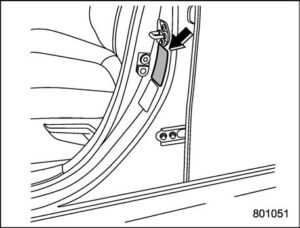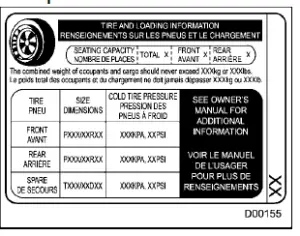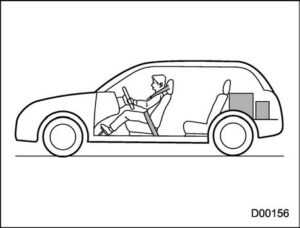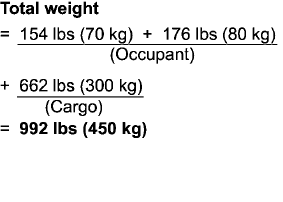Subaru Legacy 2023 Uniform Tire Quality Grading Standards Touring XT
A clever uniform tire quality system is fitted to the 2023 Subaru Legacy to guarantee both safety and maximum performance. This system offers a range of tire alternatives, including summer, winter, and all-season tires, each suited for a particular type of driving environment. In order to preserve tire integrity and vehicle stability, the car has a tire pressure monitoring system that warns the driver when tire pressure is low. It is imperative to do routine tire maintenance, which includes monitoring and modifying tire pressure, looking for wear, and following a tire rotation plan. It is crucial to use the recommended tires as stated on the tire inflation pressure label of the vehicle because the design and performance of the vehicle are optimized for particular tire sizes and kinds.
2024 Subaru Legacy Specs, Price, Features, Mileage (Brochure)
Uniform Tire Quality Grading (UTQG)
Vehicle placard
The vehicle placard is attached to the driver’s side door pillar.
Example:
The vehicle placard shows the original tire size, recommended cold tire inflation pressure on each tire at maximum loaded vehicle weight, seating capacity, and loading information
Adverse safety consequences of underinflation
Driving at high speeds with excessively low tire pressures can cause the tires to flex severely and to rapidly become hot. A sharp increase in temperature could cause tread separation, and failure of the tire(s). A possible resulting loss of vehicle control could lead to an accident.
Measuring and adjusting air pressure to achieve proper inflation
Check and, if necessary, adjust the pressure of each tire (including the spare) at least once a month and before any long journey. Check the tire pressures when the tires are cold. Use a pressure gauge to adjust the tire pressures to the specific values. Driving even a short distance warms up the tires and increases the tire pressure. Also, the tire pressures are affected by the outside temperature. It is best to check tire pressure outdoors before driving the vehicle. When a tire becomes warm, the air inside it expands, causing the tire pressure to increase. Be careful not to mistakenly release air from a warm tire to reduce its pressure.
Glossary of tire terminology
- Accessory weight
The combined weight (in excess of those standard items that may be replaced) of the automatic transmission, power steering, power brakes, power windows, power seats, radio, and heater, to the extent that these items are available as factory-in-stalled equipment (whether installed or not).
- Bead
The part of the tire that is made of steel wires, wrapped or reinforced by ply cords, and that is shaped to fit the rim.
- Bead separation
A breakdown of the bond between components in the bead.
- A bias ply tires A pneumatic tire in which the ply cords that extend to the beads are laid at alternate angles substantially less than 90 degrees to the center-line of the tread.
- Carcass
The tire structure, except tread and sidewall rubber, when inflated, bears the load.
- Chunking
The breaking away of pieces of the tread or sidewall.
- Cold tire pressure
The pressure in a tire that has been driven less than 1 mile or has been standing for three hours or more.
- Cord
The strands form the plies in the tire.
- Cord separation
The parting of cords from adjacent rubber compounds.
- Cracking
Any parting within the tread, side wall, or inner liner of the tire extending to cord material. - Curb weight
The weight of a motor vehicle with standard equipment including the maximum capacity of fuel, oil, and coolant, and if so equipped, air conditioning, and additional weight optional engine. - Extra load tire
A tire is designed to operate at higher loads and higher inflation pressure than the corresponding standard tire. - Groove
The space between two adjacent tread ribs. - Inner liner
The layer(s) forming the inside surface of a tubeless tire that contains the inflating medium within the tire. - Inner liner separation
The parting of the inner liner from cord material in the carcass. - Intended outboard sidewall
The sidewall that contains a whitewall, bears white lettering or bears manufacturer, brand, and/or model name molding that is higher or deeper than the same molding on the other sidewall of the tire, or The outward-facing sidewall of an asymmetrical tire that has a particular side that must always face outward when mounting on a vehicle. - Light truck (LT) tire
A tire is designated by its manufacturer as primarily intended for use on lightweight trucks or multipurpose passenger vehicles.
- Load rating
The maximum load that a tire is rated to carry for a given inflation pressure.
- Maximum inflation pressure
The maximum cold inflation pressure to which a tire may be inflated.
- Maximum load rating
The load rating for a tire at the maximum permissible inflation pressure for that tire. Maximum loaded vehicle weight
The sum of
- Curb weight
- Accessory weight
- Vehicle capacity weight
- Production options weight
- Maximum permissible inflation pressure
The maximum cold inflation pressure to which a tire may be inflated.
- Measuring rim
The rim on which a tire is fitted for physical dimension requirements.
- Normal occupant weight
150 lbs (68 kg) times the number of occupants specified in the second column of Table 1 is appended to the end of this section. Occupant distribution The Distribution of occupants in a vehicle as specified in the third column of Table 1 is appended to the end of this section. - Open splice
Any parting at any junction of tread, sidewall, or inner liner that extends to cord material. - Outer diameter
The overall diameter of an inflated new tire. - Overall width
The linear distance between the exteriors of the sidewalls of an inflated tire, including elevations due to labeling, decorations, or protective bands or ribs. - Passenger car tire
A tire intended for use on passenger cars, multipurpose passenger vehicles, and trucks, that have a gross vehicle weight rating (GVWR) of 10,000 lbs (4,535 kg) or less. . Ply A layer of rubber-coated parallel cords. - Ply separation
A parting of rubber compound between adjacent plies. - Pneumatic tire
A mechanical device made of rubber, chemicals, fabric steel, or other materials, that, when mounted on an automotive wheel, provides traction and contains the gas or fluid that sustains the load. - Production options weight The combined weight of those installed regular production options weighing over 5.1 lbs (2.3 kg) in excess of those standard items which they replace, not previously considered in curb weight or accessory weight, including heavy duty brakes, ride levelers, roof rack, heavy-duty battery, and special trim.
- Radial ply tire
A pneumatic tire in which the ply cords that extend to the beads are laid at substantially 90 degrees to the centerline of the tread. - Recommended inflation pressure
- The cold inflation pressure is recommended.
- 514 Tire information
mended by a vehicle manufacturer. - Reinforced tire
A tire is designed to operate at higher loads and at higher inflation pressures than the corresponding standard tire. - Rim
A metal support for a tire or a tire and tube assembly upon which the tire beads are seated - Rim diameter
Nominal diameter of the bead seat. - Rim size designation
Rim diameter and width. - Rim type designation
The industry of manufacturer’s designation for a rim by style or code. - Rim width
Nominal distance between rim flanges. - Section width
The linear distance between the exteriors of the sidewalls of an inflated tire, excluding elevations due to labeling, decoration, or protective bands. - Sidewall
That portion of a tire between the tread and bead. - Sidewall separation
The parting of the rubber compound from the cord material in the side wall. - Snow tire
A tire that attains a traction index equal to or greater than 110, compared to the ASTM E-1136-93 Standard Reference Test Tire, when using the snow traction test as described in ASTM F-1805-00, Standard Test Method for Single Wheel Driving Traction in a Straight Line on Snow-and Ice-Covered Surfaces and that is marked with an Alpine Symbol “ ” on at least one sidewall. - Test rim
The rim on which a tire is fitted for testing, and it may be any rim listed as appropriate for use with that tire. - Tread
That portion of a tire comes into contact with the road. - Tread rib
A tread section running circumferentially around a tire. - Tread separation
Pulling away the tread from the tire carcass. - Treadwear indicators (TWI)
The projections within the principal grooves are designed to give a visual indication of the degrees of wear of the tread. - Vehicle capacity weight
The rated cargo and luggage load plus 150 lbs (68 kg) times the vehicle’s designated seating capacity. - Vehicle maximum load on the tire Load
on an individual tire is determined by distributing to each axle its share of the maximum loaded vehicle weight and dividing by two. - Vehicle normal load on the tire Load on an individual tire that is determined by distributing to each axle its share of the curb weight, accessory weight, and normal occupant weight (distributed in accordance with Table 1 is appended to the end of this section) and dividing by 2.
- Wheel-holding fixture
The fixture was used to hold the wheel and tire assembly securely during testing.
Table 1 — Occupant loading and distribution for vehicle normal load for various designated seating capacities
| Designated seating capacity, number of occupants | Vehicle normal load, number of occupants | Occupant distribution in a normally loaded vehicle |
| 2 through 4 | 2 | 2 in front. |
| 5 through 10 | 3 | 2 in front, 1 in second seat. |
|
11 through 15 |
5 |
2 in front, 1 in second seat, 1 in third seat, 1 in fourth seat. |
|
16 through 22 |
7 |
2 in front, 2 in second seat, 2 in third seat, 1 in fourth seat. |
Tire care maintenance and safety practices
- Check on a daily basis that the tires are free from serious damage, nails, and stones. At the same time, check the tires for abnormal wear.
- Inspect the tire tread regularly and replace the tires before their tread wear indicators become visible. When a tire’s tread wear indicator becomes visible, the tire is worn beyond the acceptable limit and must be replaced immediately. With a tire in this condition, driving at even low speeds in wet weather can cause the vehicle to hydroplane. The possible resulting loss of vehicle control can lead to an accident.
- To maximize the life of each tire and ensure that the tires wear uniformly, it is best to rotate the tires every 6,000 miles (10,000 km). Rotating the tires involves switching the front and rear tires on the right-hand side of the vehicle and similarly switching the front and rear tires on the left-hand side of the vehicle. (Each tire must be kept on its original side of the vehicle.) Replace any damaged or unevenly worn tire at the time of rotation. After tire rotation, adjust the tire pressures and make sure the wheel nuts are correctly tightened.
Vehicle Load Limit – How to Determine
The load capacity of your vehicle is determined by weight, not by available cargo space. The load limit of your vehicle is shown on the vehicle placard attached to the driver’s side B-pillar. Locate the statement “The combined weight of occupants and cargo should never exceed XXX kg or XXX lbs” on your vehicle’s placard. The vehicle placard also shows the seating capacity of your vehicle. The total load capacity includes the total weight of the driver and all passengers and their belongings, any cargo, any optional equipment such as a trailer hitch, roof rack or bike carrier, etc., and the tongue load of a trailer. Therefore cargo capacity can be calculated by the following method.
Cargo capacity = Load limit − (total weight of occupants + total weight of optional equipment + tongue load of a trailer (if applicable))
CAUTION
Your vehicle is neither designed nor intended to be used for trailer towing. Therefore, never tow a trailer with your vehicle.
Calculating total and load capacities varying seating configurations
Calculate the available load capacity as shown in the following
Examples 1
For example, if a person weighing 176 lbs (80 kg) now enters the same vehicle (bringing the number of occupants to two), the calculations are as follows
- Calculate the total weight.
- Calculate the available load capacity.
- The total weight now exceeds the capacity weight by 81 lbs (37 kg), so the cargo weight must be reduced by 81 lbs (37 kg) or more
- The result of step 2 shows that a further 95 lbs (43 kg) of cargo can be carried.
Example 1

For example, if a person weighing 176 lbs (80 kg) now enters the same vehicle (bringing the number of occupants to two), the calculations are as follows.
- Calculate the total weight.
 The total weight now exceeds the capacity weight by 92 lbs (42 kg), so the cargo weight must be reduced by 92 lbs (42 kg) or more.
The total weight now exceeds the capacity weight by 92 lbs (42 kg), so the cargo weight must be reduced by 92 lbs (42 kg) or more.
FAQ
All-season, summer, and winter (snow) tires.
It sends a warning when tire pressure is severely low. The system activates only when the vehicle is driven.
Inflate tires higher than the label’s recommended pressures if adjusting in a warmer environment than the outside.
At least once a month and before long journeys.
On the tire inflation pressure label located on the driver’s side door pillar.
Correct wheel balance ensures smooth driving and prevents steering and suspension problems. Wheels should be balanced regularly and after tire repairs or rotation.
When the tread wear indicator becomes visible, indicating the tread depth is 0.063 inches (1.6 mm) or less.
Some tires may have a specific rotational direction, indicated on the sidewall.
Refer to the “Warranty and Maintenance Booklet” for the rotation schedule.
No, all tires should match the size and construction specified on the tire inflation pressure label for optimal performance and safety.
It can cause severe tire flex, overheating, tread separation, and potential loss of vehicle control.
Tire pressure increases when the tire warms up, so checking them cold gives a more accurate reading.
It’s recommended to use tires that match the specifications of the original equipment for safety and performance.
It can lead to reduced controllability, poor ride comfort, abnormal wear, and can impact speedometer and odometer accuracy.
Check and adjust the tire pressures to the correct levels. If the light stays on, have the TPMS checked by a Subaru dealer.
Useful Link
View Full User Guide: Subaru Legacy 2023 Touring XT User Guide
Download Manuals: https://www.subaru.com/owners/vehicle-resources/manuals.html
2024 Subaru Legacy Specs, Price, Features, Mileage (Brochure)


